Exploring the Birthstone for April 28: Color and Meaning
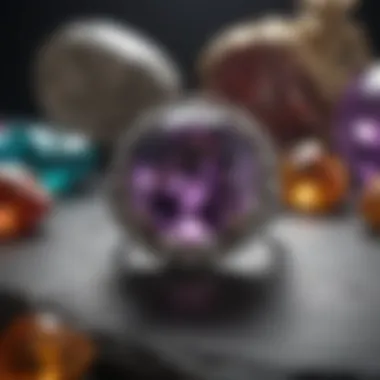
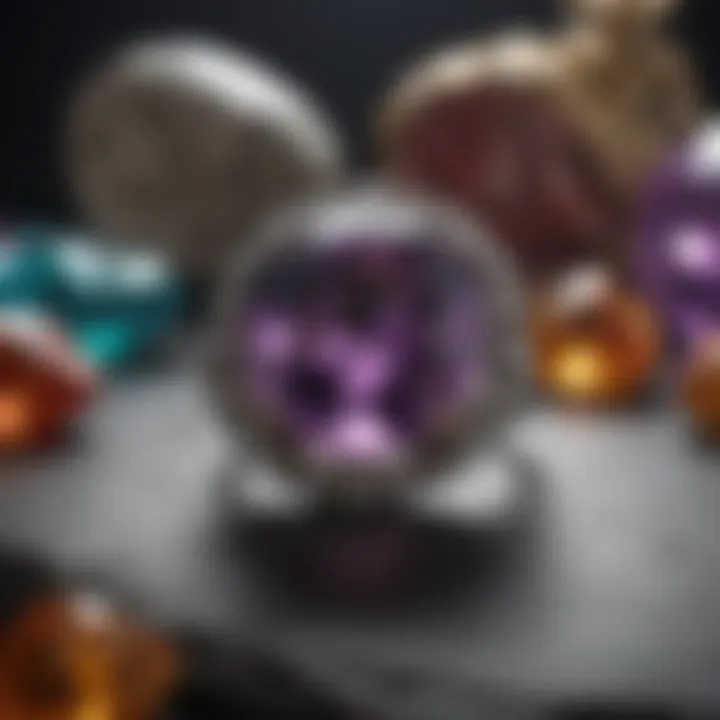
Intro
The conversation around birthstones is often a captivating one. Each birthstone carries its own story, reflecting personal identity and cultural heritage. For those born on April 28, the corresponding stone invites a closer examination of its distinctive traits, colors, and what it symbolizes. It covers not only its vivid hues but also its deep-rooted significance in society, history, and even metaphysics. This exploration seeks to enrich understanding for gemstone enthusiasts, collectors, and anyone drawn to the beauty of these natural wonders.
Gemstone Overview
Definition and Characteristics
A birthstone is often defined as a specific gemstone that is believed to confer particular benefits to the wearer based on their birth month or date. The birthstone for April 28, known for its striking brilliance and captivating color, embodies a blend of tradition and uniqueness. The vibrant shades are not just a feast for the eyes; they also carry stories spanning generations.
Characteristics of this gemstone vary, yet its most prominent qualities include clarity, luminosity, and a robust hardness that stands the test of time. The fascinating interplay of light within the stone often draws admiration, making it a popular choice for jewelry.
Classification of Gemstones
Gemstones are classified in several ways. The main categories can be divided into precious and semi-precious categories. Historically, diamonds, sapphires, emeralds, and rubies fall into the precious category, while a wide variety of stones such as garnets, amethysts, and opals are grouped as semi-precious.
This birthstone encapsulates a unique essence that straddles the line between these classifications, making it both desirable and accessible. The classification extends to physical properties, colors, and even lore associated with each type, enriching the narrative of gemstones.
Properties of Gemstones
Physical Properties
The physical properties of gemstones reveal much about their formation and appeal. These properties primarily include hardness, luster, and refractive index. This specific birthstone scores high on the Mohs hardness scale, meaning it's durable and suitable for daily wear. Its luster often appears radiant, enhancing its charm within the realm of fine jewelry.
Chemical Properties
Chemically, this gemstone consists of distinct minerals that confer its signature color. The molecular makeup plays a significant role in the facets that reflect light, creating dazzling effects for the onlooker. Variations in trace elements can result in a spectrum of colors, amplifying both its value and its allure. This interplay of chemistry and aesthetics is a crucial aspect of understanding the stone's wide-ranging appeal.
"The true beauty of a gemstone lies not only in its physicality but also in the stories it tells through colors and origins."
In essence, the birthstone for those born on April 28 is more than just a piece of jewelry or a mere accessory. It encapsulates a deep connection to personal identity, cultural history, and metaphysical beliefs, making its significance rich and multifaceted for its admirers.
Overview of April Birthstones
When it comes to April, two gems typically come to mind: diamond and the less known blue sapphire. Each of these minerals stands as a testament to both nature’s marvel and human artistry. Understanding the significance of these birthstones can reveal insights into personal connections and cultural attributes. For those born in April, their birthstones are not just pretty stones — they are symbols packed with meanings that stretch across ages and cultures.
Historical Background
Diamonds have been the quintessential April birthstone for centuries. Their allure isn’t just in their brilliance but also in their storied past. The word “diamond” derives from the Greek word "adamas," meaning invincible, which hints at the belief that they grant strength and unconquerable power. Ancient civilizations, particularly those in India, cherished diamonds, treating them as tokens of love and protection. They also believed that the clarity of a diamond could reflect one’s inner truth. Historically, they were primarily sourced from India before the discovery of diamonds in Brazil and later in Africa, drastically altering their availability and value.
Blue sapphires came into the picture much later, yet their significance cannot be understated. This gem has ties to royalty and is often regarded as a symbol of wisdom, loyalty, and nobility. In the Middle Ages, clergy wore sapphires to symbolize heaven, and many believed that they provided divine protection. This stone holds its ground in both history and contemporary society.
Modern Significance
In today’s world, the significance of April birthstones is multi-faceted. They represent personal identity and cultural heritage. Individuals born in this month may gravitate towards diamonds, finding in them a representation of resilience, integrity, and unyielding strength. The sparkle of a diamond often parallels a hopeful spirit, and many see it as a charm against negativity.
Conversely, blue sapphire often speaks to emotional clarity and creativity. Those aligned with this stone might focus on its calming influence amidst challenges. It's said to amplify intuition and can be reflective of a strong personal belief system. Whether one chooses diamond or sapphire, each brings its own unique enlightenment to the wearer.
In the marketplace, these gemstones symbolize a range of qualities sought after in possessions. For gem collectors and jewelers alike, understanding the characteristics and values of these stones is vital to appreciating their beauty and significance.
As April unfolds, those born within this month not only celebrate their birthdays but also embrace gems that embody a rich heritage, vibrant attributes, and a lasting impact on personal identity.
In essence, the journey into the world of April birthstones opens further discussions on their colors, properties, and cultural meanings, weaving a tapestry of human expression through the ages.
Understanding the Birthstone Color
The concept of birthstone colors is not just a quirky little fact to pass around at parties; it's a richer tapestry woven through history, culture, and psychology. Each color reflects not only the aesthetic qualities of a stone but also its emotional resonance and significance. In this segment, we’ll take a closer look at what it truly means to understand the color of a birthstone. Recognizing these colors can enhance one’s appreciation and personal connection to these gems. It draws in enthusiasts, collectors, and jewelry designers alike, inviting them to explore deeper meanings.
What is a Birthstone Color?
At its core, a birthstone color serves as a representative hue assigned to specific months throughout the year. For April, the commonly recognized birthstone is diamond, radiating clarity and brilliance. However, birthstone colors extend beyond just the primary gem; they often encapsulate the lore and symbolism tied to the stone. The colors can convey various emotions, including passion, love or tranquillity. For instance, while a blue sapphire might speak of serenity, a passionate red ruby might evoke feelings of love.
The color of a birthstone can influence various aspects of one’s life. Many consider the shade and clarity of the stone to be significant forces of luck and personal growth. In this light, a birthstone's hue becomes not just a visual element but a connector to one’s identity.
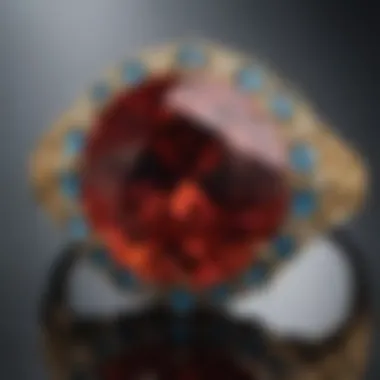
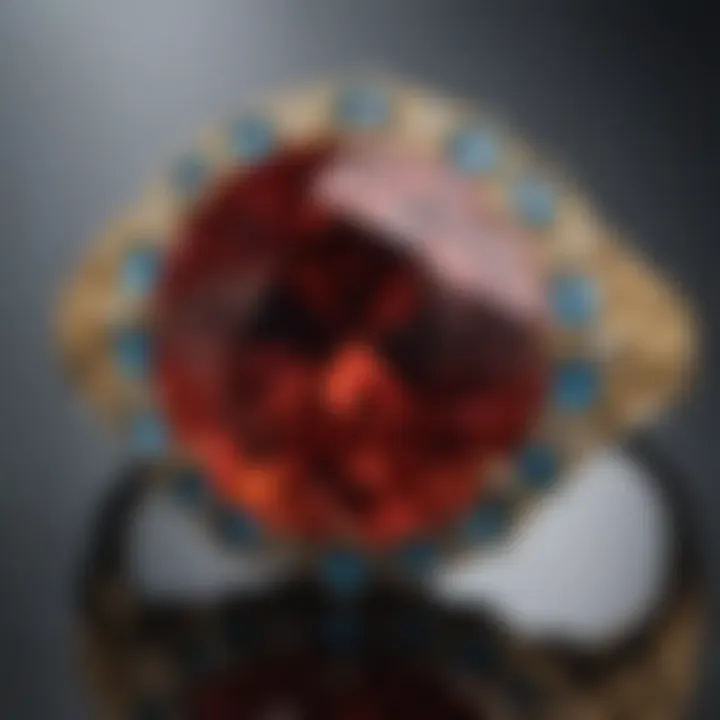
The Color of April's Birthstone
April’s primary birthstone, the diamond, dazzles with its remarkable transparency and versatility. Though it is predominantly seen as colorless, diamonds can occur in a spectrum of colors like blue, yellow, and even pink, each carrying its own distinct allure and connotations. The colorless diamond remains a symbol of purity and invincibility, attributed to its hardness.
"A diamond's color, or lack thereof, doesn't just speak to beauty; it also resonates with the spirit of those born in April."
For someone born on April 28, the nuances of the diamond’s colors can mirror the complexities of their identity—creating a canvas for personal expression. This makes it essential to consider how these colors may reflect personal beliefs or aspirations.
Additionally, the brilliance of diamond's cut allows it to interact with light in unique ways, making it a captivating choice for jewelry design. As the stone twinkles, it invites admiration and curiosity, embodying the multifaceted journey of the individual it represents. Each diamond's hue may invoke different feelings or memories, making it deeply personal to its wearer.
In summary, understanding the color of April's birthstone unveils layers of meaning, far beyond the surface. It opens pathways to insight into oneself and the world around them.
Gemstone Characteristics
Understanding the characteristics of a gemstone is essential for anyone interested in aquiring, collecting, or designing jewelry. These properties not only influence the aesthetic allure but also play a vital role in the gemstone's value, durability, and overall appeal. For the birthstone associated with April 28, delving into its physical and optical properties reveals crucial insights that can help buyers make informed decisions.
Physical Properties
The physical properties of a gemstone determine its tangible aspects, such as hardness, density, and chemical composition. For April’s birthstone, which is often identified as diamond, these properties are particularly noteworthy. Diamonds rates a 10 on the Mohs scale of mineral hardness— the highest possible score. This unrivaled hardness makes diamonds highly resistant to scratches, ensuring that jewelry retains its beauty over time.
Moreover, the density of a diamond, typically around 3.5 grams per cubic centimeter, confirms its compact structure — this is crucial when considering weight and feel in jewelry design. Not only does this density lend a solid, substantial feel to pieces, but it also enhances the perceived quality of the gemstone.
Here's a summary of key physical properties of diamonds:
- Hardness: 10 on the Mohs scale.
- Density: Approximately 3.5 g/cm³.
- Chemical Composition: Carbon atoms arranged in a crystal lattice.
Understanding these attributes can help collectors and enthusiasts appreciate why diamonds are a symbol of luxury and endurance. They are not just beautiful but are also practical for everyday wear, maintaining their charm without easily succumbing to damage.
Optical Properties
Optical properties refer to how light interacts with a gemstone, influencing its brilliance and color. When it comes to diamonds, the way light refracts and reflects off their facets creates that dazzling display that many find enchanting. Diamonds are particularly noted for their brilliance, which is the brightness created by internal and external reflections of light.
One of the significant features of diamonds is their high refractive index, which is around 2.42. This means they bend light more dramatically, leading to more sparkling effects. In essence, the more light a diamond captures and reflects, the more fire— the colorful flashes seen within the gem— it showcases.
Additionally, the presence of various impurities can influence the color and clarity of diamonds. Pure diamonds are colorless, yet they can come in fascinating hues like blue, yellow, or even pink due to these inclusions.
To summarize the optical properties of diamonds:
- Refractive Index: 2.42.
- Brilliance: High reflection creating bright sparkle.
- Color Variability: From colorless to various shades dependent on impurities.
"A diamond may be the hardest substance known, but it is its optical brilliance that makes it truly exceptional and treasured."
Cultural Significance of the Birthstone Color
The birthstone associated with April 28 carries with it a wealth of cultural meanings, illustrating how deeply rooted gemstones are in human tradition. The color of this stone does not merely serve as an aesthetic quality; it encapsulates stories, beliefs, and sentiments from various societies around the globe. Understanding these associations widens our appreciation of the gemstone, revealing its multifaceted significance.
Symbolism Across Cultures
Throughout history, gemstones have played pivotal roles in cultural practices, many of which hinge on the color of the stone. For instance, the vibrant hues of the April birthstone often symbolize clarity and purity. In ancient cultures, clear gemstones were considered to have protective powers, believed to ward off negative influences.
In Western traditions, the light blue shades of this gem are often linked to serenity and peace. The Greeks and Romans prized these stones, connecting them to deities and using them in spiritual rituals. Their blue colors were thought to encompass the vastness of the sky and sea, representing truth, wisdom, and tranquility—a notion echoed in many artistic expressions of the time.
In contrast, in Eastern cultures, the connotations can differ. For example, in certain Asian societies, colors manifest strong cultural connotations and can denote fortune, success, or auspicious beginnings. As such, the April gem, with its striking clarity, might be revered as a talisman that beckons wealth or positive change.
Many cultures also associate colors with astrological or zodiac signs, portraying the birthstone as a symbol of individuality and identity. This stone becomes a personal emblem, imbued with deeper meanings that resonate with the wearer.
"The colors we wear and surround ourselves with often reflect our innermost sentiments and aspirations. A gemstone embodies that expression."
Color Associations in Gemology
Examining the color characteristics within gemology reveals foundational insights about the implications of each hue. April's birthstone, like many others, features specific color properties that not only enhance its visual appeal but also augment its significance. In gemological terms, colors influence everything from valuation to perceived emotional resonance.
For instance, the light blue and transparent variations of the April stone often correlate to its rarity and desirability. Generally, the richer and more saturated a gemstone's color, the higher its market value. Collectors and jewelry designers shall often look for this saturation when selecting stones for their works.
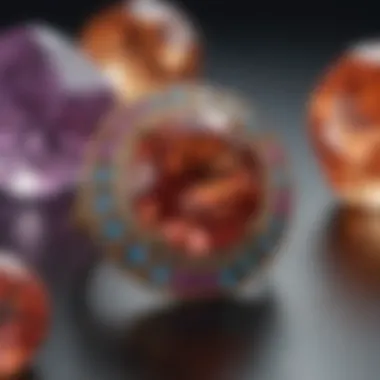
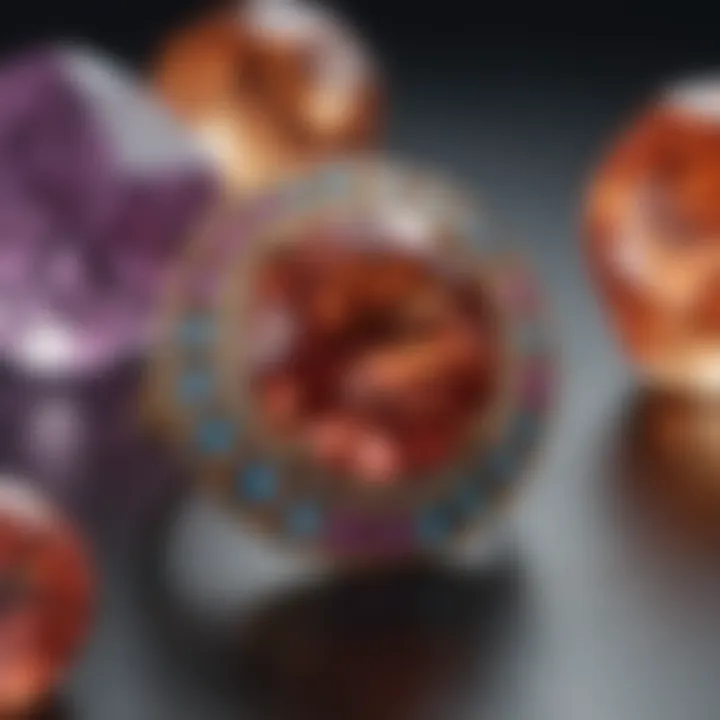
When considering color associations, the April birthstone frequently symbolizes:
- Clarity of Thought: Much like a clear sky can bring about clearer perspectives.
- Emotional Healing: Subtle blues are linked with calmness and healing energies, frequently used in practices such as mindfulness and meditation.
- Communication: The blue tones can relate to enhanced communication, urging individuals to express their thoughts eloquently.
Therefore, the cultural significance of the April birthstone shapes how individuals perceive both themselves and their gemstones. It acts as a bridge between the physical and metaphysical realms, leading to profound personal insights. Ultimately, understanding these connections informs a deeper appreciation for the aesthetic and emotional roles that such stones play in our lives.
Metaphysical Properties
Delving into the metaphysical properties of a gemstone opens a door to an intriguing world. These properties often shape how individuals connect with their stones, influencing their emotional and spiritual well-being. For those born on April 28, the birthstone holds significant metaphysical value.
Healing Attributes
Many believe that the birthstone associated with April 28 carries potent healing attributes. Gemstones can allegedly channel energy, helping to balance emotions and restore harmony. The stone functions like a little battery, potentially energizing its owner and removing negative energies. Healing practitioners often use it in various forms—rings, pendants, or even raw stones—to aid in physical and emotional healing.
Some of the notable claimed benefits include:
- Stress Relief: Many users report a decrease in anxiety and tension when in contact with their birthstone, engaging its natural properties to foster calmness.
- Boosting Confidence: The birthstone may act as a sort of talisman, instilling courage and resilience during challenging times. People often wear it to enhance their self-esteem in social situations.
- Physical Well-Being: Some alternative medicine practitioners suggest that the gemstone aids in healing ailments like headaches or digestion issues, though these claims should be approached with caution and respect for medical advice.
“Crystals and gemstones are seen not just as pretty stones, but as tools for personal growth and emotional healing. For those connected to their birthstone, it’s like a guiding star.”
Influence on Personal Identity
The influence of the birthstone on personal identity is profound. People often feel a deep connection to their stones, which can reflect their personality or aspirations. For April 28 birthdates, this connection can symbolize resilience and creativity. It’s intriguing how many individuals report feeling aligned with the qualities their birthstone embodies.
This connection manifests in several ways:
- Expression of Character: Wearing the birthstone can serve as a statement of one’s identity, revealing aspects of personality that might otherwise remain hidden. It can be a conversation starter that leads to shared stories and experiences.
- Manifestation of Goals: Individuals might use the birthstone as a focal point in manifesting their objectives. It is not uncommon for people to meditate with their stone, envisioning their goals and channeling the energy to make them a reality.
- Cultural Identity: For some, the birthstone serves as a bridge to their cultural roots, reconnecting them with traditions and histories that have long been forgotten.
Selecting the Right April Birthstone
Choosing the right birthstone can be more than a mere aesthetic endeavor; it plays a significant role in personal expression and identity. For those born on April 28, the birthstone not only reflects their personality but also holds cultural and historical meaning that resonates deeply. This section highlights important elements that one should consider while selecting an April birthstone, along with specific benefits that can arise from making a well-informed decision.
A birthstone can be considered a personal talisman, often thought to bring good luck, protection, or emotional strength. Thus, understanding what each gem offers can impact a person’s choice significantly. When selecting an April birthstone, individuals should reflect on the stone's meanings, styles, and their own personal preferences.
Tips for Purchase
When it comes to buying the right April birthstone, it’s worth keeping several tips in mind:
- Research Different Gemstones: Though diamonds are the most recognized April birthstone, alternative stones like opals or quartz can also be considered.
- Check Certifications and Authenticity: Ensure the gemstone comes with a proper grading report from a reputable lab. This guarantees quality and authenticity.
- Understand Your Budget: These gemstones can vary widely in price, so it’s essential to set a budget. Remember, while a larger gem might seem more appealing, clarity and color can often be more important.
- Consider Different Settings: The right setting can enhance the gemstone's appearance. Think about whether you prefer gold, silver, or another metal to complement the stone’s color.
- Seek Expert Advice: Consulting with gemologists or jewelers can provide valuable insights into choosing the best stone for you.
Quality Indicators
When evaluating the quality of an April birthstone, certain indicators can help determine the gem's worth and overall appeal:
- Clarity: High-quality stones should have minimal inclusions or blemishes. This clarity level can directly affect the stone's brilliance.
- Cut: The cut impacts how light interacts with the gemstone. A well-cut stone will have better sparkle and aesthetic appeal.
- Color: For diamonds, color is rated from D (colorless) to Z (light yellow or brown). The most valuable diamonds are typically colorless, but personal preference plays a large role here.
- Carat Weight: While larger stones are often perceived as more desirable, the visual proportion to the setting is what truly matters.
- Durability: April birthstones should also withstand daily wear. Diamonds, for instance, are exceptionally durable compared to other gemstones.
"A gemstone not only adorns; it tells a story and carries emotional weight."
Incorporating these tips and quality indicators during your selection process can lead to a more satisfying purchase. Knowing what to look for ensures that the April birthstone you choose not only meets your needs but also becomes a cherished piece of your identity.
The Birthstone in Jewelry Design
Jewelry design often serves as a canvas for artistic expression. The birthstone associated with April 28 invites creativity and personal expression through its incorporation in adornments. Understanding the role of this gemstone in jewelry reveals more than mere aesthetics; it highlights emotional significance, craftsmanship, and historical context.
Historical Uses in Adornment
Historically, birthstones have played a significant role in jewelry. The practice of using certain gemstones in adornment goes way back to ancient civilizations. For instance, the ancient Romans believed that wearing their corresponding birthstone empowered the individual, offering protection and good luck.
People often crafted intricate settings for these gems, using materials like gold, silver, or even wood to enhance the natural beauty of the stones. Notable examples include:
- Royal Crowns: Kings and queens often wore crowns adorned with their birthstones as symbols of their status.
- Religious Artifacts: Birthstones were also incorporated into religious symbols, emphasizing their spiritual significance.
- Talismanic Use: Throughout history, individuals have worn birthstone jewelry as protective talismans against misfortune.
Such historical contexts enrich the perception of the birthstone, transforming it from a mere gemstone to a significant emblem in personal ornamentation.
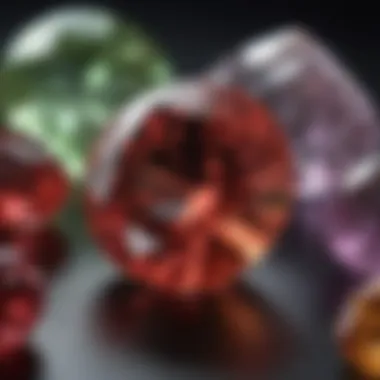
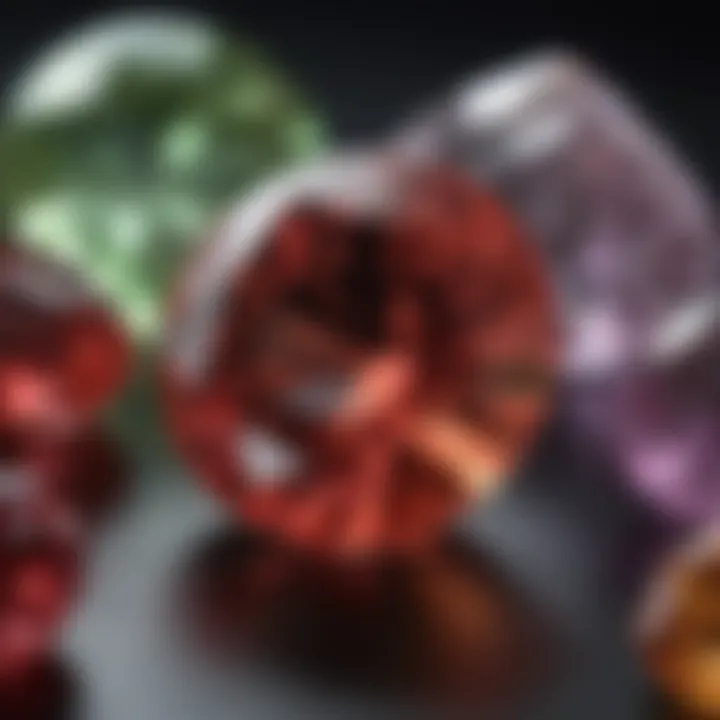
Contemporary Trends
Today, the relevance of birthstones in jewelry design continues to evolve. Modern consumers seek to express their identities and stories. The April 28 birthstone, with its vivid hue and rich background, fits nicely into many styles of contemporary jewelry. Some of the latest trends include:
- Minimalistic Designs: Many designers prefer sleek, understated designs that highlight the stone's natural beauty without overwhelming it.
- Customized Jewelry: Tailoring pieces around personal stories or meanings, such as engraving alongside the gemstone, is gaining momentum.
- Sustainable Practices: Eco-conscious consumers often prefer ethically sourced birthstones, steering attention towards more sustainable jewelry options.
- Stacking Rings: This trend allows individuals to layer various rings, incorporating multiple birthstones to symbolize different aspects of their lives.
By understanding these contemporary trends, one can appreciate how birthstones like that of April 28 not only reflect individual taste but also cater to broader cultural shifts towards personalization in jewelry.
Care and Maintenance of Your Gemstone
Caring for your gemstone is not just a matter of keeping it looking good; it's about preserving its charm and value over time. The birthstone for April, often associated with diamonds, is known for its brilliance and durability, but it still requires proper handling and maintenance to ensure that it retains its luster. In this section, we will break down the cleaning practices and storage tips, allowing gemstone enthusiasts, collectors, and jewelry designers to fully appreciate their prized possessions.
Cleaning Practices
When it comes to cleaning your birthstone, a gentle yet effective approach is crucial. Diamonds, despite their toughness, can accumulate dirt and oils from everyday wear. Here are a few best practices for keeping your April birthstone sparkling:
- Use lukewarm water: Start by mixing warm water with a few drops of mild dish soap. Avoid harsh chemicals that can damage the stone.
- Soft brush: Grab a soft-bristled toothbrush or a jewelry brush to gently scrub the stone. Focus on the underside of the gemstone where grime tends to build up.
- Rinse thoroughly: After cleaning, rinse the gem under lukewarm water to remove any soap residue. Make sure to catch it in a bowl or plug the sink to avoid any mishaps.
- Dry with a microfiber cloth: Finish by patting the gemstone dry with a soft microfiber cloth. It’s less likely to cause any scratches compared to traditional cloths.
"Regular cleaning not only enhances your gemstone's appearance but also maintains its longevity, crucial for showing off its full potential."
Storage Tips
Proper storage of your gemstone is equally important. The way you store it can prevent scratches, chips, or even loss. Here are some practical tips to consider:
- Individual compartments: Store each piece of jewelry separately. If you have multiple pieces, using a jewelry box with individual slots can keep them safe.
- Avoid direct sunlight: Prolonged exposure to sunlight can fade the color of some gemstones, although diamond is more resilient. Still, for general jewelry care, keeping them in a cool, dark place is wise.
- Use a fabric pouch or wrap: For extra protection, wrap your gemstone in a soft fabric pouch or cloth before placing it in a box. This adds a layer of defense against potential scratches.
- Temperature control: Try to store your gemstones at a stable temperature. Extreme fluctuations can affect the physical properties of some stones.
Taking care of your gemstone goes beyond mere aesthetics; it’s about preserving its heritage and ensuring it serves as a cherished token for generations. Whether you're a collector or a casual wearer, understanding these cleaning and storage practices is essential for enjoying your April birthstone to the fullest.
Exploring Alternative April Birthstones
When one thinks of April’s birthstone, the shimmering diamond immediately comes to mind. However, it’s worth taking a detour down the winding path of alternatives that also represent this month in a unique way. Exploring alternative April birthstones can unveil a treasure trove of colors, meanings, and personal significance. For individuals born on April 28, these alternatives might just resonate on a deeper level, providing insight and connection beyond the conventional.
Comparative Analysis
- Tradition vs. Variety: While diamonds boast a rich history as symbols of strength and clarity, other gems such as white sapphires and moissanite offer distinct beauty with their own merits. For those who prefer a more modest choice, white sapphires present a valuable option, being durable yet more affordable, often preferred for everyday wear without losing elegance.
- Emotional Resonance: Each gemstone carries its own emotional resonance. For some, a white sapphire acts as a conduit of balance and peace, especially in a chaotic world. Moissanite, on the other hand, is known for its exceptional brilliance and fire, reflecting a vibrant personality. Thus, one’s personal experiences and emotions should guide the choice of their alternative birthstone.
- Quality Considerations: From the durability of diamonds to the relative softness of some alternatives, understanding these gems’ physical properties can influence decision-making. For example, while diamonds score a 10 on the Mohs scale, white sapphires sit at a 9, meaning they are also suitable for daily wear, but a bit more fragile compared to their diamond counterpart.
Choosing Personal Preferences
This section is about understanding oneself through gemstone selection.
Deciding on an alternative birthstone is not simply about aesthetics. Rather, it involves a reflective journey into personal values and preferences. Ask yourself the following:
- What do you value most in a gem? Is it brilliance, emotional meaning, or perhaps, ethical sourcing? Understanding your core values will guide your choice.
- Do certain colors resonate more with you? For instance, if you’re drawn to purity and clarity, white sapphires might speak to you more than a traditional diamond.
- What’s your lifestyle? If activity is a daily must, durability comes into play more than flexibility of design. In contrast, for hands-off individuals, any gem will do.
In choosing personal preferences, one may even seek out semi-precious stones like rock crystal or even clear quartz, both serving as budget-friendly options that can embody personal energies or intentions.
The importance of this exploration lies not just in the gems themselves, but in what they symbolize for you. Choose carefully, as your birthstone, traditional or alternative, becomes part of your identity.
In wrapping up this exploration of alternative April birthstones, it becomes clear that the journey through color, meaning, and personal expression is both enriching and revelatory. Each stone, whether it be diamond, white sapphire, or moissanite, provides a distinct narrative to those born in this month, allowing for a variety of choices that extend well beyond standard traditions.
Closure
The conclusion serves as a pivotal element in understanding the role and significance of the April 28 birthstone. It encapsulates the essence of what has been explored throughout the article, connecting various threads of information regarding the stone's history, color meaning, and its impact on personal identity. For readers—jewelry designers, gemstone enthusiasts, and collectors—the conclusion delivers a cogent summary of insights while aligning with their interests.
Summary of Key Insights
The discussion on April 28's birthstone emphasizes several key takeaways:
- Historical Dimension: The origins and historical significance of the birthstone shed light on its traditional uses and transformations over time.
- Color Symbolism: The rich hues associated with the stone not only dictate its aesthetic appeal but also contribute to the meanings attached to it across various cultures.
- Metaphysical Attributes: This gemstone is often believed to possess energies that reinforce identity, healing, and personal growth, resonating well with those born under this sign.
- Personal Connection: The exploration of alternative choices allows individuals to align the birthstone with their particular tastes and preferences, highlighting the very personal nature of such gems in one's life.
Collectively, these insights deepen the understanding of how the birthstone transcends its physical properties, impacting emotional and spiritual dimensions for those it represents.
Final Thoughts on Birthstones
The symbol of a birthstone goes beyond being merely a piece of jewelry; it is a reflection of one's journey and identity. For those born on April 28, the associated gem encapsulates both personal and cultural narratives, making it distinctly significant.
As we further engage with the birthstones in our lives, let us appreciate not just their beauty, but also their capacity to connect us with our heritage, values, and aspirations. Whether it's a piece meant for daily wear or a cherished item to mark a profound life event, the April birthstone makes for a stylish and meaningful accessory. In the grand tapestry of life, such stones can serve as bright threads, weaving together our individual stories with the rich history of gemstones.
Thus, when reflecting on your own birthstone and its symbolism, ask yourself: what story does it tell about you?



